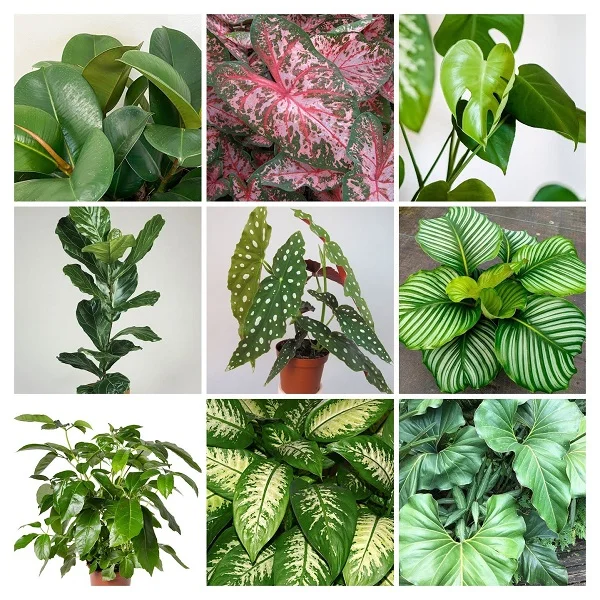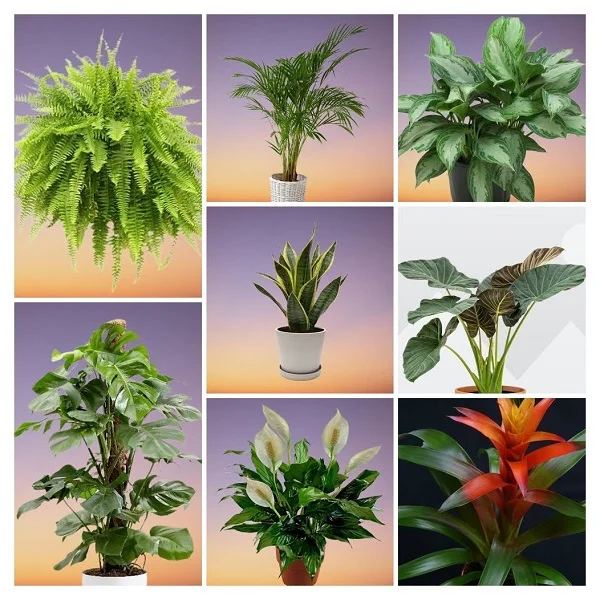Philodendron elegans (Finger-leaf Philodendron) Indoor Care, Propagation, Problems and Solutions
Some links in this post may be affiliate links
Philodendron elegans (Finger-leaf Philodendron) flourishes in medium to bright indirect light, warm and humid conditions and moderately moist, rich, well-drained soils coupled with monthly feeding in the growing season.
Finger-leaf Philodendron is a rare, easy-care, and dramatic plant to add to your collection. This guide will help you understand its light, water, soil, propagation methods, and how to solve common problems.
Philodendron elegans also called Skeleton Key Philodendron or Skeleton Aroid is one of the sought-after Philodendron varieties on account of its size and highly divided stately leaves.
The leaves come in various shades of green and a glossy sheen. They are highly divided which gives them the appearance of a palm's frond.
Finger-leaf Philodendron has a creeping and a climbing growth habit. Like Silver Sword Philodendron (Philodendron hastatum), Spadeleaf Philodendron (Philodendron domesticum), Blushing Philodendron (Philodendron erubescens) and Philodendron ilsemanii 'Variegata', Philodendron elegans requires a moss pole or a trellis to support it to grow upright.
Philodendron elegans is considered to be one of the rare, low-light plants and is often mistaken for Philodendron radiatum, Philodendron mayoi, Philodendron lancerum or Philodendron tortum due to the pinnate foliage.
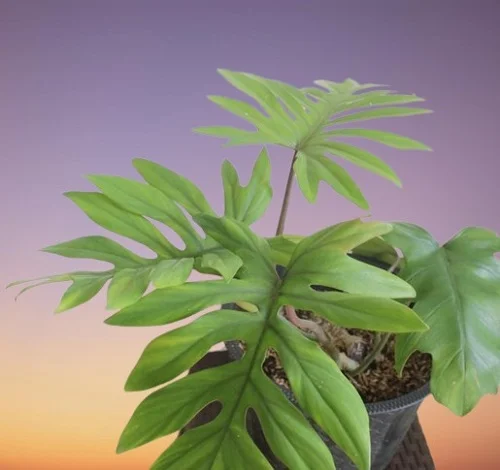
Botanical name: Philodendron elegans
Family: Araceae
Common name: Finger-leaf Philodendron, Skeleton Key Philodendron, Skeleton Aroid
Origin
Philodendron elegans is native to the tropical forests of Brazil and Colombia where it grows as a hemiepihyte; it grows both epiphytically and terrestrially.
Size
Skeleton Key Philodendron can grow to about 33 feet in its native habitat but indoors it grows to about 6-8 feet. The leaves can grow to 1.8 feet long by 1 foot wide.
Is Philodendron elegans toxic?
Philodendron elegans like other Philodendrons is toxic to both humans and pets as indicated by National Capital Poison Center. The plants contain Calcium oxalate crystals. If ingested, it can cause burning and swelling in the mouth and throat, vomiting, diarrhea and abdominal pains. Therefore, keep it away from the reach of children, cats, dogs, and other pets.
Where to Buy
Finger-leaf Philodendron is an excellent addition to any plant collection. You may acquire the plant from Etsy (Link to Etsy).
How do you care for a Philodendron elegans indoors?
Caring for Philodendron elegans indoors involves giving it medium to bright indirect light (filtered light), average warmth of 16-280C, humidity of 60-70% and moderately moist, fertile, well-drained soils coupled with monthly feeding during the growing season.
Finger-leaf Philodendron care requires regular pruning to keep the plant neat, encourage a bushy growth and rejuvenate growth. Repotting of the young plant is needed when it becomes pot-bound while the large plants require annual replenishment of the soil. Keep reading for more on these conditions and how to best to provide them.
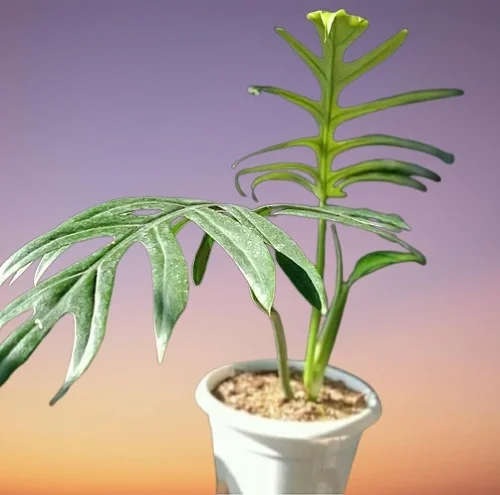
Watering
How often should I water Philodendron elegans?
Do not water Philodendron elegans on a schedule to avoid either underwatering or overwatering, both of which will negatively affect the growth of the plant.
Water your Philodendron elegans liberally in spring and summer while allowing the top 2-3 inches of soil to dry out between waterings. Keep the soil moderately moist but never soggy to prevent yellowing of leaves.
Cut down on the amount and frequency of watering in fall and winter as growth is minimal at this time. Do not allow the soilball to dry out completely to avoid wilting and drooping leaves.
Use filtered or rainwater to avoid getting brown leaf tips and edges. Ensure that the water is at room temperature to steer clear of shocking this tropical plant which can result in slowed growth.
To stay away from soggy soil, use a pot that has a drainage hole and well-draining soil. Soggy soil can lead to root-rot and death of the plant.
Light Requirements
How much light does Philodendron elegans need?
Philodendron elegans grows best in medium to bright indirect light (dappled light). Keep it away from direct sunlight to avoid scorching the leaves.
Make sure that it receives adequate light as insufficient light will result in leggy growth and small-sized pale leaves. If the natural lighting is too low, you may grow the plant under grow lights.
For uniform growth and to prevent unbalanced growth, turn the pot every so often to ensure that the plant receives light on all sides.
Temperature and Humidity
Philodendron elegans thrives in an average warmth of 16-280C. Keep it away from drafts to prevent extreme temperatures as they can harm the plant.
Very high temperatures can cause yellowing and leaf drop while too low temperatures can result in reduced growth or death of the plant.
Finger-leaf Philodendron requires a humidity of 60-70% to thrive. Low humidity for prolonged periods can result in curled leaves and brown leaf tips and edges. To up humidity, set the pot on a wet pebble tray or use a humidifier. Make sure that there is good air flow to prevent fungal diseases.
Fertilizer
Feed your Philodendron elegans every 3-4 weeks in spring and summer with a balanced, water-soluble fertilizer for a lush growth. Too much fertilizer may cause a leggy growth and yellow leaves.
Do not feed in fall and winter as growth is slowed at this time. Feeding at this time can cause fertilizer burn and death of the plant.
Regularly flush out accumulated salts from the soil by running a stream of water through the soil until it drips through the drainage hole.
Potting Soil
The best potting soil for Finger-leaf Philodendron is a well-draining, nutrient-rich mix that retains moisture without getting waterlogged. A mix of 40% orchid bark (for aeration), 30% peat moss or coco coir (to retain moisture), 20% perlite (to improve drainage), and 10% worm castings or compost (for nutrients) is ideal for this plant.
Repotting
Repot your Philodendron elegans every 2-3 years in the beginning of the growing season only when the plant becomes root-bound to avoid overpotting.
Select a pot 1 size larger than the current one that has a drainage hole to avoid root-rot. Check out these pots with drainage holes and saucer on Amazon.
Replenish the top 2-3 inches of soil of large plants in the beginning of the growing season or as necessary. Take care not to injure the roots to avoid fungal infestations.
The large plant can also be divided at repotting to propagate new plants if you need to increase your collection or share with friends and family.
Pruning & Maintenance
Pruning Finger-leaf Philodendron involves:
- Removal of yellow and dead leaves to maintain the plant neat and also minimize pests and diseases.
- Cutting back the stems of a straggly plant to the soil level in the beginning of the growing season to rejuvenate growth.
Regularly clean the leaves by damp-wiping with a soft cloth to get rid of dust and to discourage pest and disease infestations.
Philodendron elegans Propagation
Philodendron elegans (Finger-leaf Philodendron) propagation can be done in late spring to early summer from stem cuttings or by plant divison. The stem cuttings can be rooted in soil or in water.
1. Propagating Philodendron elegans from stem cuttings in soil
- Take a stem cutting of about 4-5 inches long from a healthy plant by cutting the stem below a leaf node with a sharp, clean pruning scissors.
- Strip off the lower leaves to expose the nodes.
- Insert 2-3 inches of the lower cut end of the cutting in moist, well-drained soil.
- Place the set up in a warm, well-lit place and maintain the soil moist until new growth has emerged.
- Allow the new plants to be well established before transplanting into individual pots after which you can begin routine care.
2. Propagating Philodendron elegans from stem cuttings in water
- With a sharp, sterlized scissors, take a stem cutting of about 4-5 inches long from a healthy plant by cutting the stem below a leaf node.
- Remove the lower leaves to expose the nodes as this is where new growth will emerge from.
- Place the lower cut end of the cutting in a jar of clean water while ensuring at least on leaf node is below the water surface.
- Position the set up in a well-lit place and change the water every 5-7 days until the roots have developed.
- Transfer the new plants into individula pots in moist, free-draining soil when the roots are about 2-3 inches long.
- Place the pots in bright indirect light and maintain the soil moist until the new plants are well established.
- Once the new plants are well established, transfer the pots to their permanent position after which you can begin routine.
3. Propagating Philodendron elegans by plant division
- Water the plant thoroughly at least 1 day before to make it easier to divide and also hasten establishment.
- Carefully, tease the plant out of its pot and divide rootball into sections while ensuring each section has enough roots.
- Pot these sections into individual pots in moist, loose, free-draining soil.
- Place the set up in a warm, brightly-lit place away from direct sunlight.
- Maintain the soil moist until the new plants are well established after which you can begin routine care.
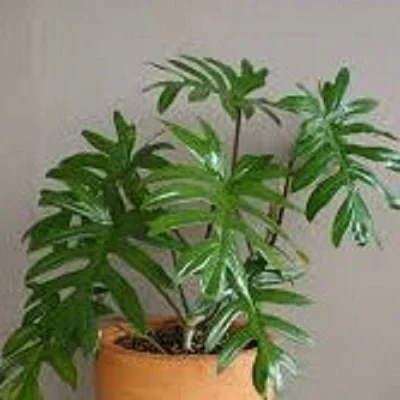
Philodendron elegans Problems & Remedies
Philodendron elegans (Finger-leaf Philodendron) problems are yellow leaves, brown leaves, plant dying, drooping leaves, brown leaf tips and edges, leggy growth, pests and diseases among others. Keep reading for more on these problems and how to fix them.
Yellow leaves
The main causes of yellow leaves on Philodendron elegans are inconsistent watering, too little light, soggy soil, and nutrients deficiency.
How to fix it
Inconsistent watering: Do not water on a schedule. Water when the top 2-3 inches of soil to dry out.
Too little light: Position the plant infront of a large, well-lit window but shield it from direct sunlight.
Soggy soil: Use a pot with a drainage hole and well-draining soil.
Nutrients deficiency: Feed every 3-4 weeks in spring and summer with a balanced water-soluble fertilizer.
Brown leaves
Some of the causes of brown leaves on Philodendron elegans are underwatering, direct sunlight, and salts buildup.
How to fix it
Underwatering: Water when the top 2-3 inches of soil dry and do not leave the soil to dry out completely.
Direct sunlight: Keep the plant away from direct sunlight or use a light curtain to filter the sunlight.
Salts buidup: Flush out accumulated salts from the soil every 1-2 months by running a stream of water through the soil until it drips through the drainage hole.
Plant dying
Philodendron elegans is dying due to root-rot which is prevalent in soggy soil. The disease is characterized by yellowing and wilting of the leaves which is rapidly followed by browning and plant collapse.
How to revive a dying plant
- Carefully slip the plant out of its pot and inspect the roots.
- Trim brown-black mushy roots and treat the healthy roots with a copper-based fungicidal solution as indicated on the label.
- Disinfect the pot with the fungicidal solution or use a fresh pot to repot the plant in fresh, well-draining soil.
- Do not water the plant immediately; keep it dry for 5-7 days before you can resume watering.
- To prevent root-rot in the future, use a pot with a drainage hole and well-draining soil to prevent the soil from getting soggy.
- Cut down on watering in fall and winter as growth is reduced at this time; maintain the soil slightly moist.
Drooping leaves
Drooping leaves on Philodendron elegans are due to underwatering, overwatering, temperature stress, and spider mite infestation.
How to fix it
Underwatering: Water the plant immediately and it should recover.
Overwatering: Withhold watering until the top 2-3 inches of soil feel dry to the touch.
Temperature stress: Keep the plant away from hot drafts emanating from hot air vents, heat source and others to maintain an average warmth of 16-280C.
Spider mite infestation: Regularly inspect the plant for any infestation and treat it appropriately. Keep the plant well pruned.
Brown leaf tips and edges
Brown leaf tips and edges on Philodendron elegans are caused by dry air and being pot-bound.
How to fix it
Dry air: Set the pot on a wet pebble tray to raise humidity or grow the plant in a brightly-lit bathroom or other moist areas in the home.
Being pot-bound: Repot the plant into a pot 1 size larger that has a drainage hole to prevent the soil from getting soggy.
Leggy growth and small pale leaves
Leggy growth and small pale leaves on Philodendron elegans is due to low light and overfertilizing.
How to fix it
Low light: Move the plant to a more brighter spot or instal a grow light if the natural light is inadequate.
Overfertilizing: Feed every 3-4 weeks in spring and summer only. Take care not to overfeed.
Pests
Common pests in Philodendron elegans are spider mites, aphids, scales and mealybugs.
How to fix it
- Isolate the affected plant to prevent spread to the rest of the plants and treat it with neem oil or insecticidal soap as per the manufacturers' instructions.
- Increase humidity by use of a humidifier or a wet pebble tray to discourage the pests.
- Regularly clean the leaves by damp-wiping with a soft cloth to keep the pests away.
- Keeping the plant well pruned reduces the hiding and breeding places for these pests.
Diseases
Philodendron elegans is prone to powdery mildew and leaf spot disease which are enhanced by overwet conditions coupled with poor air circulation.
How to fix it
- Seperate the affected plant to prevent spread to the other plants and spray it with a fungicidal solution. Ensure to follow the manufacturer's recommendations.
- Avoid misting and wetting the foliage; water from the bottom instead.
- Ensure that there is good air circulation for your plant.
- Clean the leaves regularly by damp-wiping with a soft cloth to minimize the diseases infestations.
- Keep the plant well pruned to reduce the breeding places for these diseases.
Conclusion
Philodendron elegans is a gorgeous, easy-care plant that makes a bold statement in any indoor space. By providing proper light, humidity, and well-draining soil, you can enjoy its lush, unique foliage for years to come. With patience and care, your Finger-leaf Philodendron will thrive and become a standout feature in your indoor jungle.
You liked it? Share on social media.
Related Content
Amazon Associates Disclosure
Homeplantsguide.com is a participant in the Amazon Services LLC Associates Program, an affiliate advertising program designed to provide a means for sites to earn advertising fees by advertising and linking to amazon.com.




